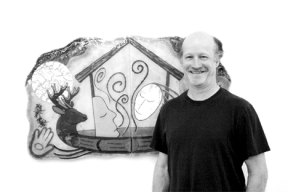It happened with just a handful of people.
But it would revolutionize the glass art world.
It was a new art form called fused glass.
Whidbey Island glass artist Richard La Londe has put together the whole funky, colorful history and fascinating technique in a beautiful book entitled, “Richard La Londe: Fused Glass Art and Technique.” Pioneer glass blower Fritz Dreisbach wrote the introduction for the book.
Even if you’re not interested in the techniques of kiln-formed glass or art in general, the history of the subject is compelling. And being one of the major players and innovators who was around in the 1980s when it was all happening makes La Londe the perfect storyteller.
La Londe was one of the first four people to be hired and trained by the Bullseye Glass Company in Portland, Ore. — one of the country’s main suppliers to glass artists at the time — and later became one of the company’s first fusing instructors. (All of his art pieces shown in the book were made at Bullseye Glass.)
La Londe’s tone in the book is of someone telling a new friend an old story that he wants to preserve for posterity.
“In 1975, I stumbled into the Bullseye Glass Company and couldn’t believe what they were doing,” writes La Londe. “Out front was a huge pile of broken clear bottles; inside were a bunch of ‘hippies’ casting and rolling sheets of glass they had made from melted bottles.”
La Londe’s pioneering experiences from the early days at Bullseye to the present are invaluable to those who want to know more about the dates and detail of fusing techniques; it’s also a must-read for glass artists of every ilk.
The book takes readers on an artful journey of La Londe’s personal glass art experience that’s meshed with the history of other innovative fusing artists, along with the technical aspects of the form right down to a clear and concise photo montage and step-by-step outline of kiln-building.
The book was written, designed and laid-out by La Londe and printed under the title of Ozone Press, La Londe’s own publishing house.
Local designer Vicki Grayson fine tuned the color adjustment and did the final book packaging for the printer.
The author does an excellent job of laying out the book with a vast collection of photographs of his own art, the art of his colleagues, and the faces of those who were on the cutting edge of the fusing movement.
The book is also peppered with great, informative photos that show various fusing techniques, such as leaf under glass, leaf on top of glass and foil fused in glass.
La Londe is passionate about letting people know the story behind fused glass.
“It’s a very personal book,” he said. “Some of the people who developed these methods have died.”
“It was time for me to take stock of my life; see where I’ve been and see what the next phase is going to be,” La Londe said.
Besides focusing on his new career as a writer, La Londe continues to create art in his Freeland studio. He holds workshops throughout the year, where 12 glass artists at a time stay for about four days on the island.
La Londe said people come from all over the country to learn his techniques.
He also said that he realized that many people didn’t have any idea of how these techniques came about or who had developed them. That inspired him to write the first book.
Now, he wants to write more.
“I’ve got a lot more to say,” La Londe said.
His next book has the working title of “Richard La Londe and Friends: Vitreous enamels and other techniques.” He is also planning a children’s picture book using his fused glass as pictorial art.
He is currently at work on a Washington State Art Commission for an elementary school in White Center. It is a large, triptych wall mural using three pictorial glass panels depicting a neighborhood of diverse cultures unifying their way toward peace through education.
“I’m the old-timer now,” said La Londe. “So I want to get it all down.”
“Richard La Londe: Fused Glass Art and Technique” is available at Moonraker Books in Langley and at La Londe’s Website at www.richardlalonde.com. Workshop information is also available at the Website or by e-mail at lalonde@whidbey.com.



